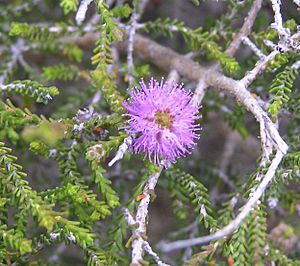South coast beaufortia facts for kids
Quick facts for kids South coast beaufortia |
|
|---|---|
 |
|
| Scientific classification | |
| Genus: |
Beaufortia (plant)
|
| Species: |
empetrifolia
|
| Synonyms | |
|
Melaleuca empetrifolia Rchb. |
|
South coast beaufortia, also known as Beaufortia empetrifolia, is a beautiful plant. It belongs to the myrtle family, just like eucalyptus trees! This plant is special because it only grows in the south-west of Western Australia. It's a bushy shrub with lots of branches. It has tiny leaves packed closely together. In warmer months, you can see its pretty pink or purple flowers. They look a bit like small bottlebrushes! It's quite similar to another plant called Beaufortia micrantha, but its leaves are a little bigger.
Contents
What Does South Coast Beaufortia Look Like?
The south coast beaufortia is a compact, bushy shrub. It can grow up to 2 m (7 ft) tall. Its leaves are arranged in a cool way. They grow in opposite pairs, making four neat rows along the stems. Each leaf is shaped like an egg. They are about 1.5–3 mm (0.06–0.1 in) long and 0.5–2 mm (0.02–0.08 in) wide.
Flowers and Reproduction
The flowers of this plant are usually pink to purplish-red. They grow in round clusters, about 20 mm (0.8 in) across. These flower clusters are found at the ends of the branches. Interestingly, the branches keep growing even after the flowers bloom!
Each flower has five sepals and five petals. It also has five groups of stamens. Stamens are the parts of the flower that make pollen. Each group usually has three to five stamens. These stamen groups are a bit hairy. They are joined together for part of their length, then they spread out.
You can often see this plant flowering in almost any month. It depends on the weather! After the flowers, the plant produces fruits. These fruits are woody capsules. They are about 6.5–11.5 mm (0.3–0.5 in) long and 5–6 mm (0.20–0.24 in) wide. Sometimes, these capsules even join together!
Where Does South Coast Beaufortia Grow?
The south coast beaufortia is mainly found in Western Australia. You can see it in areas between Albany and Esperance. It grows in sandy soil. Often, you'll find it near large granite rocks.
Is South Coast Beaufortia Protected?
The Western Australian Government's Department of Parks and Wildlife has classified Beaufortia empetrifolia as "not threatened." This means it's not currently at risk of disappearing.

